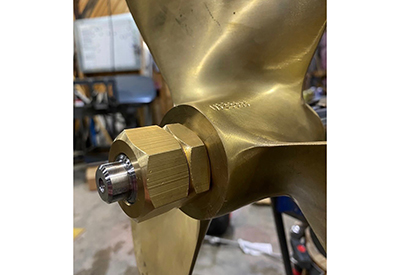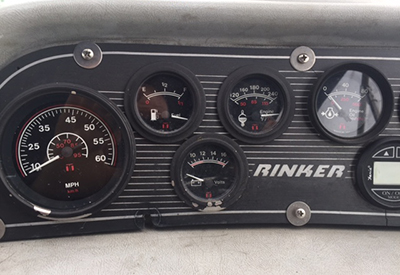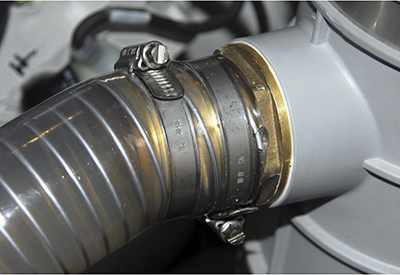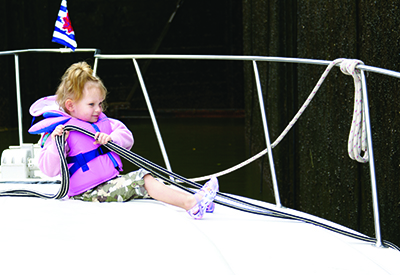Ask Andrew – Carbon Monoxide
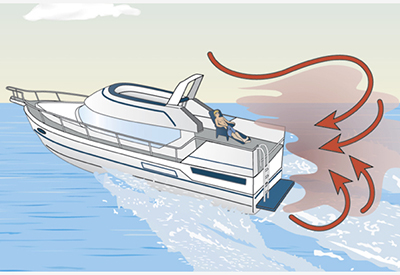
Oct 28, 2021
When operating at a slow idle, carbon monoxide can build up and blow back into the vessel.
As the seasons change and we move from warm summer into cooler fall, many fanatic boaters (especially those with cabin space) begin to use on-board heaters to extend the boating season. I was recently asked about some of the dangers associated with having heaters aboard – and I launched into a lecture about ventilation and the danger of Carbon Monoxide.
As I thought about the subject after the fact, I realized that there’s a bigger story, here. The story is so big, in fact, that there are questions on carbon monoxide on the test necessary in obtaining your boater’s license (Pleasure Craft Operator’s Card) in Canada. That said, to most boaters, carbon monoxide poisoning is one of those terms that they hear, but without understanding exactly what it is, it’s dangers, and methods of detection and prevention.
Anything aboard that involves burning a fuel (engine combustion (gas or diesel), diesel/propane onboard heaters, fuel burning stoves, generators, and barbeques), produces carbon dioxide by the natural incomplete burning of the oxygen in the air. If the oxygen being burned is coming from enclosed cabin spaces, it will no longer be available for breathing – all that will be left is the poisonous carbon monoxide exhaust gas.
The statistics are frightening: US coast guard ranks carbon monoxide poisoning among the top 5 causes of death of boaters. According to a 2017 US coast guard report: there have been 800 reported cases of carbon monoxide poisoning related to boating in the last 15 years (2002-2017), with 140 fatalities. In Ontario from 2001 to 2007 (the last period I can find numbers for), there were 74 accidental deaths from asphyxia due to furnace fumes and vehicle exhaust.
To make matters worse, the term ‘silent killer’ is highly accurate: Carbon monoxide is colourless and odourless. That said, there are a number of preventative measures that can be taken aboard, to protect yourself and your guests from being exposed and injured:
 These exhaust tubes are inadequately secured to the boats muffler, potentially leaking exhaust fumes into the engine compartment.
These exhaust tubes are inadequately secured to the boats muffler, potentially leaking exhaust fumes into the engine compartment.
1) Where both gas and diesel engines produce carbon monoxide, gasoline engines produce higher levels
2) Cold, poorly tuned, and overloaded engines produce more CO thank warm, properly tuned and load-matched engines
3) Each engine aboard (running engines and generators) should have their own exhaust line, venting exhaust gases overboard
4) Engine compartment blowers should be properly positioned, operable, with blower hoses secured and no rips/tears in the hose
5) Despite CO gases being vented overboard, boaters should still be aware of how CO gases can collect :
a. Boats with aft canvas enclosures can create the ‘station wagon effect’: exhaust gases are captured beneath the canvas and don’t allow the CO to disperse
b. Swimmers/waterskiers should be kept well away from the exhaust vents when engines/generators are running
c. Swimmers should stay away from areas where CO gases can accumulate: beneather or around swim platforms and between pontoons
d. When rafting two vessels together, or docking against a seawall, CO can collect in areas that might otherwise be well ventilated
e. When riding with the bow high, exhaust gases may collect in cabin spaces and enclosed areas
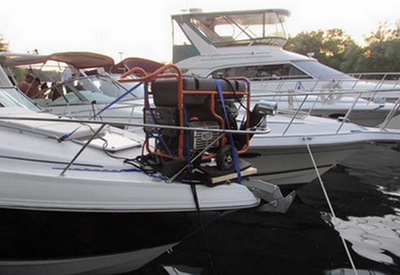 While not an ideal generator installation, at least the generator is in a well ventilated area!
While not an ideal generator installation, at least the generator is in a well ventilated area!
6) Cabin heaters that burn fuel (wood, paper, diesel) should have an independent exhaust flue, allowing exhaust to be vented topside
7) Non-electric stoves, water heaters and other appliances should never be used when unattended or when users aboard are sleeping (when CO poisoning symptoms may not be evident), and should only be used during periods when there is adequate ventilation in the cabin spaces
Beyond all of these preventative measures, is the detection of the poisonous gases. The American Boat and Yacht Council (ABYC) standard for carbon monoxide detection systems (A-24) requires that any boat with a cabin or sleeping area requires a CO detector. CO detectors can be battery powered, or wired into the boat’s electrical system (but should include a block on the electrical panel to prevent the detector from being accidentally turned off). CO detectors had received negative reviews in past years due to their tendency to go off during periods of high humidity and other ‘nuisance type’ alarms. Modern CO detectors, especially those designed for marine use have been improved significantly.
Please read this as you stow your boat:
A final note, as a reminder for those who are involved with winterizing and shrink-wrapping – whether you’ve hired a contractor or are a do-it-yourselfer: Heat shrink guns produce a very high level of CO as shrink-wrap plastic is being heated. Be careful in areas of poor ventilation, and never heat shrink-wrap from the inside of the wrap.
Stay safe on the water.
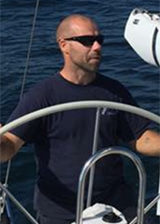 Andrew McDonald is the owner of Lakeside Marine Services – a boat repair/maintenance firm based in Toronto. Andrew has worked in the marine industry for 12 years and is a graduate of the Georgian College ‘Mechanical Techniques – Marine Engine Mechanic’ program.
Andrew McDonald is the owner of Lakeside Marine Services – a boat repair/maintenance firm based in Toronto. Andrew has worked in the marine industry for 12 years and is a graduate of the Georgian College ‘Mechanical Techniques – Marine Engine Mechanic’ program.
Questions or comments for Andrew? Email him directly via: askandrew@lakesidemarineservices.ca

